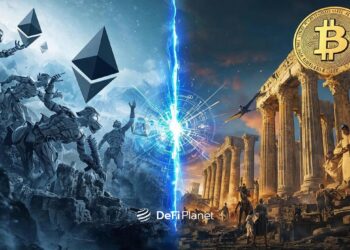Despite being one of the oldest cryptocurrencies, Bitcoin has had to play to catch up with newer counterparts and undergo significant changes to its original design.
For example, the original design of the blockchain that ushered in the development of the cryptocurrency space did not include essential features like smart contracts found in modern blockchains.
However, Bitcoin is constantly evolving in its own right, and over the years, it has incorporated many improvements to its original design. These updates have helped it maintain its position as the blockchain to beat in the crypto space. One of the recent improvements is the introduction of the BRC-20 token standard.
Although BRC-20 tokens are in an experimental stage, they have garnered attention within the Bitcoin community due to their potential to revolutionize user interactions with the blockchain. Infrastructure providers such as wallet services and marketplaces are beginning to incorporate BRC-20, allowing their users to create and trade these tokens.
In this article, we will explore the BRC-20 token standard, what it is, how it works, and its use cases.
What Is BRC-20?
BRC-20 is an experimental token standard based on Bitcoin’s Ordinals protocol, which enables users to create, use, and send fungible tokens.
The BRC-20 token standard establishes a set of regulations for creating and managing these fungible tokens on the Bitcoin blockchain.
Brief History of BRC-20
In November 2021, Bitcoin underwent a network update called Taproot. This update increased the data capacity of Bitcoin blocks and opened doors to innovations like the Ordinal protocol.
Before Taproot, there were attempts to add more data to the Bitcoin blocks, but there was no standard way, and it wasn’t widely practiced.
Fast forward to January 2023, Casey Rodarmor introduced the Bitcoin Ordinals protocol. In simple terms, this protocol allowed users to add information to individual Satoshis, the smallest Bitcoin units.
Initially, the protocol was primarily utilized for crafting non-fungible Bitcoin tokens.
Famous NFT creators like Yuga Labs and DeGods released Bitcoin Ordinals collections, and they sold out fast. New collections like Taproot Wizards and BitcoinFrogs also became very popular.
People were excited about “Ordinals” because Satoshis were naturally rare. Each Satoshi had a distinctive history, and those mined within the first 1000 blocks or by Bitcoin’s founder, Satoshi Nakamoto, were particularly valuable due to their scarcity resulting from Satoshi’s extended inactivity.
While this uniqueness attracted NFT collectors, it also had its drawbacks. The increased adoption of Bitcoin wallets led to network congestion and higher fees. Nonetheless, this surge in activity spurred innovation as individuals began creating new and compelling ordinals, eventually laying the groundwork for the BRC-20 standard.
In March 2023, Ethereum developer Domo, also known as @domodata on X (formerly Twitter), introduced the BRC-20 standard as a framework for a new token standard to create ordinals on the Bitcoin blockchain.
How Do BRC-20 Tokens Work?
Before diving into how BRC-20 tokens work, it’s crucial to understand the technology behind them, called the Ordinals protocol.
The Ordinals Protocol makes it much easier to add extra data, like text, pictures, or audio, to Bitcoin blocks. It turns Satoshis, the smallest unit of Bitcoin, Sats (short for Satoshis), into data-encoded units by assigning a “serial number” based on their order of creation on the Bitcoin blockchain. As a result, each Satoshi is allocated an ordinal number, which is the reason for the protocol’s name.
BRC-20 tokens are, in fact, a particular type of these inscribed ordinals. Regular Bitcoin ordinals can have any information, but BRC-20 tokens always have JSON (JavaScript Object Notation) data. This code gives the ordinal extra functions. Despite BRC-20’s limitations, this simple code allows people/users to create, make, and send tokens on the Bitcoin network.
Potential Use Cases of BRC-20 Tokens
Although BRC-20 token development is still in its early stages, there are a number of potential applications for them. They can be used to build a community, raise funds, or increase brand recognition. Let’s take a look at some of these use cases:
- Decentralized Finance: BRC-20 tokens can improve decentralized finance (DeFi) in the Bitcoin network. This means this token can be used for services such as lending, borrowing, flash loans, and insurance.
- Crowdfunding: BRC-20 tokens can be created for IDO (Initial DEX Offering) launchpads to raise funds for new projects in the Bitcoin network.
- Community Tokens: BRC-20 tokens can also play an important role in organizing and maintaining communities for projects on the Bitcoin network. For example, PFP (profile picture) projects are emerging in the Bitcoin realm, BRC-20 tokens can be used to enhance their presence.
- In-App Tokens: If developed correctly, BRC-20 standard tokens can be used within other apps like marketplaces and games. They can help with transactions, governance, and offering rewards within those apps.
Why BRC-20 is Getting Popular
The BRC-20 token standard has received lots of attention from developers and users lately because it has successfully found a way to make the most of the Bitcoin network’s strength and widespread use.

Let’s talk about some of the token standard’s key strengths and what it offers its users.
- Security: The BRC-20 standard leverages the strong security of the Bitcoin blockchain, which is renowned for its top-notch security features. Its decentralized nature, advanced algorithms, and proof-of-work consensus collectively combine to enhance the overall security of the system.
- Simplicity: In contrast to token standards that depend on complex smart contracts, the BRC-20 standard uses a more simplified process. It skips the smart contract complexities and allows users to create and send BRC-20 tokens without advanced technical skills.
- Growth Potential: As more people use the BRC-20 standard, it is expected that new ideas and different ways to use it will spring up. With a big and diverse group of users, developers, and investors, the BRC-20 token standard will likely grow and become more advanced over time.
Drawbacks to the Use of BRC-20 Standard
Despite its many benefits, it’s important to recognize that the BRC-20 token standard, like any technology, has its built-in limitations. Let’s explore some of them:
- Lack of Smart Contract Functionality: In contrast to token standards like Ethereum’s BRC-20, BRC-20 lacks support for smart contracts. Smart contracts add automation, transparency, security, and asset control, so not having them is a limitation for BRC-20.
- Dependency on the Bitcoin Blockchain: BRC-20 depends on the Bitcoin blockchain, which has limitations like low scalability and slow transactions. So, as BRC-20 usage increases, these challenges could become more noticeable, impacting how efficiently and cost-effectively it operates.
- Interoperability Challenge: The BRC-20 standard results in the creation of tokens exclusive to the Bitcoin blockchain. This makes it harder to move tokens between different networks and thus, seamless interaction of these tokens with other blockchain systems is quite difficult.
- Limited Utility: BRC-20 excels in handling fungible assets but falls short when it comes to managing non-fungible assets or advanced token features. This limitation restricts its suitability for projects that require specialized token capabilities and features.
- Novelty and Unproven Capabilities: As BRC-20 tokens are relatively new, they carry inherent risks. Even cryptocurrency experts may have uncertainties about this fungible token standard. While there’s growth potential, there’s also a risk of failure. In the absence of a track record of proven projects, BRC-20 remains a relatively untested concept.
Difference between BRC-20 and ERC-20 tokens
The BRC-20 is essentially Bitcoin’s version of Ethereum’s ERC-20 tokens, albeit with unique attributes.

These token standards operate on two separate blockchain platforms; BRC-20 on Bitcoin and ERC-20 on Ethereum. The result of this is distinct consensus mechanisms for each. Ethereum uses Proof-of-Stake with validators staking ETH for transactions, while Bitcoin relies on Proof-of-Work with miners solving puzzles to validate transactions.
Another notable contrast lies in the utilization of smart contracts. ERC-20 tokens make extensive use of smart contracts, a feature absent in BRC-20 tokens. Ethereum’s smart contracts execute transactions based on predefined conditions, while BRC-20 tokens rely on the Ordinals protocol and inscriptions for fungibility.
Unlike smart contracts that permit condition changes, inscriptions are immutable, as they are directly engraved onto a satoshi and impervious to modification by any counterparty.
ERC-20 tokens are widely used in DeFi, while BRC-20 tokens are still experimental and new. You can easily buy ERC-20 tokens on exchanges like Binance, UniSwap, and Coinbase, but this isn’t the case for BRC-20 tokens.
What’s Next for BRC20 Tokens?
The BRC-20 token market is booming; more than 14,709 unique tokens already use this standard, and the number keeps increasing. The total market value for the tokens is approaching about $1 billion.
As the DeFi sector continues to grow, more tokens and financial products are likely to embrace BRC-20, especially due to its connection with Bitcoin.
Also, the standard developers are rapidly expanding and are dedicated to enhancing its features and making it easier for developers to create tokens.
Despite being relatively new, BRC-20 demonstrates considerable potential. And interest in this standard continues to grow, it may well compete with established standards like ERC-20 and BEP-20.
Only time will tell if BRC-20 tokens become a fundamental part of the DeFi industry or remain a temporary trend in the crypto space.
Disclaimer: This article is intended solely for informational purposes and should not be considered trading or investment advice. Nothing herein should be construed as financial, legal, or tax advice. Trading or investing in cryptocurrencies carries a considerable risk of financial loss. Always conduct due diligence.
If you would like to read more articles (news reports, market analyses) like this, visit DeFi Planet and follow us on Twitter, LinkedIn, Facebook, Instagram, and CoinMarketCap Community.
“Take control of your crypto portfolio with MARKETS PRO, DeFi Planet’s suite of analytics tools.”





















